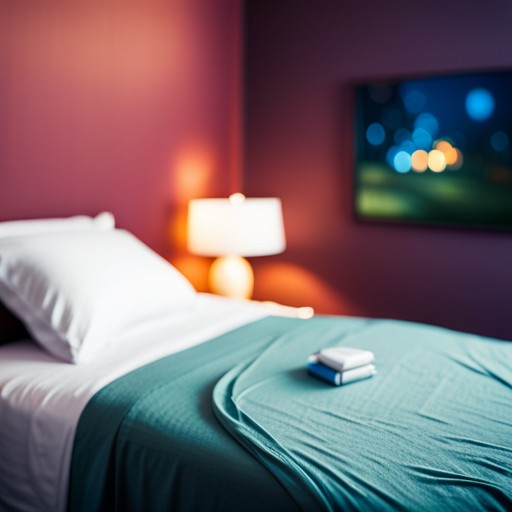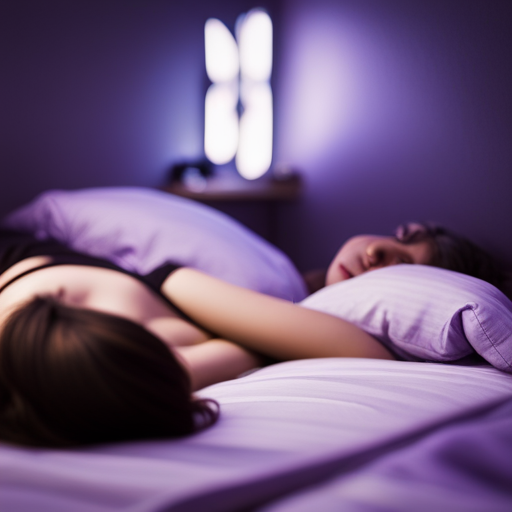I understand your thoughts. “Why do I experience such vivid dreams?” I have pondered over this question many times myself. It feels like my mind transforms into a colorful amusement park when I sleep, with bright colors, strong emotions, and strange situations that leave me feeling perplexed yet fascinated.
But rest assured, there is a scientific explanation behind this phenomenon.
In this article, we will delve into the intriguing world of dreams and explore the various factors that contribute to their vividness. From the science behind dreams to psychological factors, sleep quality, external influences, and even the impact of our lifestyle choices, we will uncover the secrets behind these immersive nocturnal experiences.
So, if you’ve ever found yourself waking up with a vivid dream still fresh in your mind, or perhaps struggling to understand the meaning behind these nightly journeys, then this article is for you.
Get ready to embark on a fascinating exploration of the why’s and how’s of vivid dreams and discover how harnessing their power can lead to a deeper understanding of ourselves.
Key Takeaways
- Increased brain activity during REM sleep leads to vivid and lifelike dream experiences.
- Stress and emotional experiences can influence dream intensity and content.
- Psychological factors like emotional arousal, unresolved conflicts, and personality traits contribute to vivid dreams.
- Sleep disorders like insomnia and sleep apnea disrupt sleep cycles and affect dream patterns.
The Science Behind Dreams
Have you ever wondered why you have such vivid dreams? The science behind dreams is a fascinating field that has been extensively studied by psychological researchers.
Through their studies, they have discovered that dreams are a result of brain activity during sleep. During REM (rapid eye movement) sleep, which is the stage of sleep where dreams occur, there is increased brain activity. This heightened brain activity is believed to be responsible for the vividness of our dreams.
Research has shown that during REM sleep, the brain is highly active, with increased communication between different regions. This increased activity leads to the creation of vivid, lifelike dream experiences.
Psychological research has also found that various factors can influence the intensity and content of our dreams. Stress, for example, has been shown to increase dream vividness. Similarly, emotional experiences and events that occur during the day can also have an impact on the content of our dreams.
Understanding the science behind dreams and the psychological factors that influence them can provide valuable insights into our own dream experiences. By studying these factors, researchers hope to unravel the mysteries of the dreaming mind and gain a deeper understanding of the role dreams play in our lives.
Psychological Factors
Experience a multitude of intense and visually immersive dream sequences due to various psychological factors. Dream analysis and therapy offer insights into the reasons behind vivid dreams.
According to experts, one psychological factor that contributes to vivid dreams is emotional arousal. When individuals experience heightened emotions during the day, such as stress, anxiety, or excitement, it can significantly impact their dreams at night. These intense emotions can manifest in vivid and memorable dream experiences.
Another psychological factor is the presence of unresolved conflicts or unresolved emotions. Dreams provide a safe space for our unconscious mind to process and explore these unresolved issues, resulting in vivid and symbolic dream imagery.
Additionally, personality traits can influence dream vividness. For example, individuals who are more creative, imaginative, or introspective tend to have more vivid dreams. Understanding these psychological factors can help individuals gain insight into their dream experiences and explore their inner thoughts and emotions.
Transitioning into the next section, dream recall and journaling can further enhance the understanding and analysis of these vivid dreams.
Dream Recall and Journaling
When it comes to improving dream recall, there are several techniques that have been proven effective. One of the most popular methods is keeping a dream journal, where you write down your dreams as soon as you wake up.
By analyzing dream patterns and symbols that appear frequently in your journal, you can gain a better understanding of your subconscious mind and potentially uncover hidden meanings behind your dreams.
Techniques for Improving Dream Recall
To enhance dream recall, practicing relaxation techniques like deep breathing or meditation can greatly improve the ability to remember vivid dreams. As the saying goes, "a calm mind is like a blank canvas for dreams to paint upon." When we’re relaxed, our brain is more receptive to storing and retrieving dream memories.
Research has shown that deep breathing and meditation can reduce stress and anxiety, allowing us to enter a more peaceful state before sleep. This calmness enhances our ability to remember dreams upon awakening. By incorporating these relaxation techniques into our daily routine, we can create an optimal environment for remembering dreams.
Keeping a dream journal is the next step in this process, as it allows us to document and analyze our dreams, further improving our dream recall and understanding.
Keeping a Dream Journal
Keeping a dream journal can be a valuable tool in enhancing my ability to recall and analyze my dreams. By recording my dreams immediately after waking up, I’m able to capture the details and emotions that may fade throughout the day.
This practice allows me to identify recurring themes or symbols in my dreams, which can provide valuable insights into my subconscious mind. By analyzing these symbols, I can gain a deeper understanding of my thoughts, fears, and desires.
Additionally, keeping a dream journal helps me notice patterns in my dreams, such as common settings or recurring characters. This information can be used to further explore the meaning behind my dreams and potentially uncover hidden messages.
Analyzing dream patterns and symbols can be a fascinating way to delve into the depths of my subconscious mind.
Analyzing Dream Patterns and Symbols
Analyzing dream patterns and symbols can provide fascinating insights into the depths of our subconscious mind, offering us a unique perspective on our thoughts and emotions. Dream therapy and dream analysis techniques can help us uncover hidden meanings and unresolved issues that may be influencing our vivid dreams.
By keeping a dream journal and recording the details of our dreams, we can start to identify recurring themes, symbols, and patterns. These patterns can then be analyzed to gain a deeper understanding of our subconscious thoughts and emotions. For example, a recurring dream about falling may indicate a lack of control or fear of failure in our waking life. By recognizing these patterns and symbols, we can begin to address underlying issues and work towards resolving them.
Understanding the significance of our dreams can contribute to better self-awareness and personal growth. Transitioning into the next section about sleep quality and sleep disorders, it is important to note that analyzing dream patterns and symbols can also provide valuable insights into the nature of our sleep and potential sleep disorders.
Sleep Quality and Sleep Disorders
Sleep deprivation has a significant impact on the content and vividness of our dreams. Studies have shown that when we don’t get enough sleep, our dreams tend to be more fragmented and less memorable.
Additionally, sleep disorders such as insomnia or sleep apnea can disrupt our sleep cycles, leading to changes in dream patterns.
On the other hand, improving sleep quality can enhance the likelihood of experiencing lucid dreaming, where individuals are aware that they’re dreaming and can even control the content of their dreams.
The Impact of Sleep Deprivation on Dreams
Lack of sufficient rest can lead to more intense and memorable dreams. When we experience sleep deprivation, our brains go into overdrive during the rapid eye movement (REM) stage of sleep, which is when most dreaming occurs. This can result in vivid and detailed dreams that are more likely to be remembered upon waking. Several factors contribute to this phenomenon. Firstly, the use of certain medications, such as antidepressants or sleep aids, can affect the brain’s chemistry and increase dream intensity. Secondly, stress plays a significant role in the vividness of dreams. High levels of stress can disrupt normal sleep patterns and cause an increase in REM sleep, leading to more vivid dreams. Understanding the impact of sleep deprivation on dreams is crucial in exploring the relationship between sleep quality and dreaming. Transitioning into the next section, sleep disorders also play a significant role in shaping our dreams.
Sleep Disorders and Dreaming
Suffering from insomnia can put a damper on our dream world, leaving us tossing and turning throughout the night. Sleep disorders, such as insomnia, narcolepsy, and sleep apnea, can significantly impact our dreaming experiences.
Dream analysis has shown that individuals with sleep disorders tend to have more fragmented and less vivid dreams compared to those without these disorders. One possible explanation is that disruptions in the sleep cycle can interfere with the normal progression of sleep stages, including REM sleep, which is associated with dreaming.
Furthermore, sleep disorders can also lead to increased daytime sleepiness, which can result in a lack of mental clarity and focus, making it more difficult to recall and analyze dreams. Understanding the relationship between sleep disorders and dreaming can provide valuable insight into improving sleep quality and enhancing our dream experiences.
Transitioning into the subsequent section about "lucid dreaming and sleep quality," we can explore another aspect of dreaming that can be influenced by sleep disorders.
Lucid Dreaming and Sleep Quality
Experience the incredible phenomenon of lucid dreaming, where you can actively participate and control your dreams, resulting in a truly immersive and empowering sleep experience. Lucid dreaming techniques involve practices such as reality checks, dream journaling, and meditation to enhance dream awareness and control.
Research suggests that lucid dreaming can have numerous benefits, including improved problem-solving skills, increased creativity, and reduced nightmares. By becoming aware that you’re dreaming, you can manipulate the dream environment and explore limitless possibilities. Lucid dreaming also provides a unique opportunity for self-reflection and personal growth.
However, it’s essential to note that the quality of sleep during lucid dreaming may be affected by the increased brain activity and excitement. Understanding the influence of external factors on sleep quality can help maximize the benefits of lucid dreaming without compromising overall sleep health and well-being.
The Influence of External Factors
When it comes to the influence of external factors on our sleep and dreaming, there are several key points to consider.
First, the role of sleep environment cannot be underestimated. Factors such as noise, temperature, and comfort can all impact the quality of our sleep and the vividness of our dreams.
Second, our diet and exercise habits also play a significant role. Research has shown that certain foods and physical activity levels can affect the depth and duration of our sleep, which in turn can influence the content of our dreams.
Finally, substance use, including alcohol and drugs, can have a profound impact on our dreaming experience. These external factors all contribute to the complex interplay between our environment and our sleep, shaping the vividness and content of our dreams.
The Role of Sleep Environment
To create a sleep environment that promotes vivid dreams, you should ensure that your bedroom is a comfortable and calming space. The sleep environment plays a crucial role in setting the stage for a dream atmosphere. Here are three key factors to consider:
-
Lighting: Dim the lights and use soft, warm lighting to create a relaxing ambiance in your bedroom.
-
Temperature: Keep your bedroom cool, between 60-67 degrees Fahrenheit, as it helps promote deep sleep and vivid dreaming.
-
Clutter-free: Remove any clutter or distractions from your bedroom to create a peaceful and serene atmosphere.
Research suggests that a comfortable sleep environment can enhance the quality of your sleep, making it more likely for you to experience vivid dreams.
In the next section, we’ll explore the impact of diet and exercise on dream vividness.
The Impact of Diet and Exercise
Improving your diet and exercise routine can significantly affect the intensity of your dream experiences. Research suggests that stress and anxiety can have a direct impact on the content and vividness of our dreams. Studies have shown that individuals who experience high levels of stress and anxiety are more likely to have intense and vivid dreams.
Additionally, certain medications can also influence dream intensity. For example, antidepressants and sleep aids have been found to increase dream vividness in some individuals. It’s important to note that the impact of diet and exercise on dream intensity may vary from person to person.
However, incorporating healthy eating habits and regular physical activity into your lifestyle can have positive effects on your overall well-being, which may translate into more vivid dreams.
Moving on to the next section about substance use and dreaming, it’s important to consider the potential effects of certain substances on dream experiences.
Substance Use and Dreaming
After examining the impact of diet and exercise on dream vividness, it’s important to explore another factor that can influence the intensity of dreams: substance use. Substance induced dreams have been studied extensively in relation to altered states of consciousness.
Different substances can have varying effects on dreaming, with some substances enhancing dream vividness while others suppress dreaming altogether. For example, alcohol and sedatives are known to suppress dreaming, while psychedelics such as LSD and psilocybin can induce highly vivid and immersive dream experiences.
Understanding the relationship between substance use and dreaming is crucial in comprehending the intricate workings of the dreaming mind. Moving forward, it’s also imperative to consider the role of personality traits in shaping dreams, which will be explored in the subsequent section.
Personality Traits and Dreaming
During REM sleep, my mind becomes a vibrant playground of vivid dreams, showcasing my unique personality traits. Dreaming is a complex phenomenon that can provide valuable insights into our subconscious mind and help us understand our own personalities better. By analyzing dream patterns, researchers have identified several personality traits that can influence the content and intensity of our dreams.
-
Emotional Intensity: People with high emotional intensity tend to have more vivid and emotionally charged dreams. These dreams may often reflect their intense feelings and emotions in waking life.
-
Openness to Experience: Individuals who’re open to new experiences and have a vivid imagination are more likely to have creative and fantastical dreams. They often engage in vivid dream scenarios that involve surreal landscapes and imaginative characters.
-
Neuroticism: People with high levels of neuroticism tend to have more negative and disturbing dreams. These dreams may reflect their anxieties, fears, and insecurities.
-
Conscientiousness: Those who’re highly conscientious tend to have more organized and structured dreams. Their dreams may often involve specific goals, plans, and routines.
Understanding the connection between dreaming and personality traits can provide valuable insights into our subconscious mind. It allows us to delve deeper into our own selves and gain a better understanding of our thoughts, emotions, and behaviors. This understanding can also help us explore the connection to creativity and problem-solving, which’ll be discussed in the subsequent section.
The Connection to Creativity and Problem Solving
Engage your imagination and explore the fascinating connection between dreaming and personality traits to unlock your creative potential and enhance problem-solving abilities. When it comes to creativity and problem-solving, dreaming plays a crucial role in stimulating our imagination and helping us think outside the box. Dreams provide a unique platform for our minds to explore different scenarios, ideas, and solutions that we might not have considered in our waking lives.
One way dreams enhance our creativity is through the role of emotions. Dreams often evoke intense emotions, ranging from happiness to fear, which can be a rich source of inspiration for creative endeavors. These emotional experiences within dreams can fuel our artistic expressions, allowing us to tap into our deepest thoughts and feelings.
Moreover, dreams can assist in problem-solving by presenting us with novel perspectives and fresh insights. Sometimes, when we are faced with a complex problem, our conscious minds become stuck in conventional thinking patterns. However, during sleep, our brains continue to work on these problems in the background, making connections and associations that we may not have considered before. Upon waking, we may find that a dream has provided us with a new solution or a different approach to a challenging task.
As we explore the connection between dreaming and creativity, it’s important to delve into dream interpretation and symbolism, which can offer valuable insights into the meanings behind our dreams.
Dream Interpretation and Symbolism
Exploring the depths of our subconscious, dream interpretation and symbolism offer valuable insights into the hidden meanings behind our nocturnal visions.
Dreams are not just random images that flicker through our minds while we sleep; they’re often laden with symbolism that can provide clues about our emotions, desires, and fears. Interpreting dreams can be a fascinating and enlightening process, helping us better understand ourselves and the world around us.
When it comes to dream symbolism, there aren’t any hard and fast rules. However, certain symbols tend to have common interpretations. Here are a few examples:
- Flying: Often associated with a sense of freedom and liberation.
- Falling: May suggest a loss of control or fear of failure.
- Water: Represents emotions and the subconscious mind.
- Animals: Can symbolize different aspects of our personality or instincts.
Understanding the symbolism in our dreams can be a powerful tool for self-reflection and personal growth. By unpacking the hidden meanings, we can gain a deeper understanding of our thoughts and feelings, and even find solutions to problems we may be facing.
As we delve deeper into the impact of lifestyle choices, it becomes clear that our daily habits and routines can influence the content and intensity of our dreams.
The Impact of Lifestyle Choices
Our lifestyle choices greatly shape the content and intensity of our dreams. One important factor that influences our dreams is the practice of meditation. Research has shown that individuals who regularly engage in meditation tend to have more vivid dreams compared to those who don’t meditate. This may be attributed to the fact that meditation helps to calm the mind and enhance self-awareness, allowing for a deeper connection with the subconscious during sleep.
By quieting the mind and focusing on the present moment, meditation can create an optimal environment for the emergence of more vivid and meaningful dream experiences.
Additionally, stress management plays a significant role in the quality of our dreams. High levels of stress can disrupt sleep patterns and lead to fragmented or less memorable dreams. Conversely, when we effectively manage stress, our sleep becomes more restful, and dreams can become more vivid and memorable. This is because reduced stress levels promote a sense of relaxation and well-being, allowing for more vivid and creative dream experiences.
Understanding the impact of lifestyle choices on our dreams is essential in harnessing the power of vivid dreams. By incorporating practices such as meditation and stress management into our daily lives, we can enhance our dream experiences and gain deeper insights into our subconscious minds.
Harnessing the Power of Vivid Dreams
Tap into the power of your vibrant dreams by embracing their insights and unraveling the mysteries they hold. The early bird catches the worm by keeping a dream journal and reflecting on the symbolism and messages within your dreams. By practicing dream yoga and lucid dreaming techniques, you can enhance your dream experiences and gain a deeper understanding of yourself.
Dream yoga is a practice rooted in Tibetan Buddhism that focuses on using dreams as a spiritual path. It involves training the mind to maintain awareness during sleep and dreams, enabling one to explore the nature of consciousness. Lucid dreaming, on the other hand, is the ability to become aware that you are dreaming while still in the dream state. This awareness allows you to actively participate in and manipulate the dream.
By combining dream yoga and lucid dreaming techniques, you can tap into the immense potential of your vivid dreams. The following table illustrates some effective techniques you can incorporate into your practice:
| Technique | Description |
|---|---|
| Reality checks | Regularly question your waking reality |
| Dream journal | Record your dreams in detail |
| Reality testing | Test your environment to determine if you’re dreaming |
| Mnemonic induction of lucid dreaming (MILD) | Repeat a phrase to increase dream lucidity |
| Wake back to bed (WBTB) | Wake up midway through the night to induce lucidity |
| Visualization | Imagine becoming lucid in a dream scenario |
By diligently practicing these techniques and exploring the realm of dream yoga and lucid dreaming, you can unlock the hidden potentials of your dreams. Embrace the power of your vivid dreams and allow them to guide you on a journey of self-discovery and transformation.
Frequently Asked Questions
Can vivid dreams be a sign of a sleep disorder?
Yes, vivid dreams can be a sign of a sleep disorder. Sleep disorders such as REM sleep behavior disorder and narcolepsy can cause intense, vivid dreaming. Dream analysis is often used to diagnose and understand sleep disorders. Research shows that individuals with sleep disorders experience more frequent and intense dreaming compared to those without. This suggests a correlation between vivid dreams and sleep disorders. Seeking medical evaluation and treatment can help address any underlying sleep issues causing these vivid dreams.
Are there any specific personality traits that make someone more likely to have vivid dreams?
Psychological factors play a role in the occurrence of vivid dreams. Research suggests that individuals with certain personality traits, such as openness to experience and neuroticism, are more likely to have vivid dreams.
Additionally, stress has been linked to the frequency and intensity of vivid dreams. Studies have shown that increased levels of stress hormones can enhance dream vividness.
Therefore, personality traits and stress levels can influence the likelihood of experiencing vivid dreams.
Can external factors, such as noise or temperature, affect the vividness of dreams?
External factors, such as noise or temperature, can indeed affect the vividness of dreams. Research suggests that environmental stimuli during sleep can influence dream recall and overall dream clarity.
For instance, noise disturbances can disrupt the sleep cycle, leading to fragmented dreams and decreased recall. Similarly, extreme temperatures can impact sleep quality, potentially affecting the intensity and vividness of dreams.
Keeping a dream journal may help identify patterns between external factors and dream vividness.
Is there a connection between the content of vivid dreams and problem-solving abilities?
Dream journaling and lucid dreaming have been linked to problem-solving abilities. In a study, participants who regularly recorded their dreams in a journal showed improved problem-solving skills compared to those who didn’t.
This suggests that keeping a dream journal can enhance our ability to think creatively and find solutions to complex problems. Similarly, lucid dreaming, where one becomes aware they’re dreaming, allows for conscious exploration and problem-solving within dreams, providing further evidence of the connection between dream content and problem-solving abilities.
How do lifestyle choices, such as diet and exercise, impact the frequency and intensity of vivid dreams?
Diet and exercise can impact the frequency and intensity of vivid dreams. Studies suggest that certain foods, like spicy meals or foods high in tryptophan, can increase dream activity. Regular exercise has also been linked to more vivid dreams, possibly due to increased brain activity and improved sleep quality.
However, individual experiences may vary. It’s important to note that other factors, such as stress and medication, can also influence dream intensity. More research is needed to fully understand the relationship between lifestyle choices and vivid dreams.
Conclusion
In conclusion, the truth behind why I have such vivid dreams is a fascinating and complex topic. Through scientific research, we’ve discovered that various factors contribute to the intensity of our dreams. These factors include psychological influences, dream recall, sleep quality, external stimuli, and even lifestyle choices. The connection between vivid dreaming and creativity, problem-solving, and the power of dreams for personal growth is undeniable. By exploring these factors further, we can gain a deeper understanding of our dreams and harness their potential in our lives.










